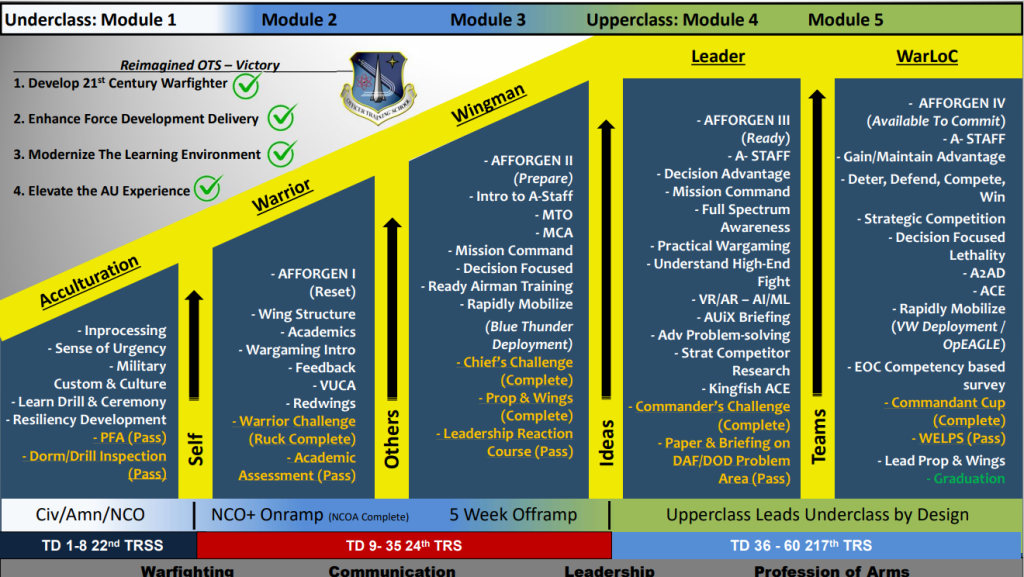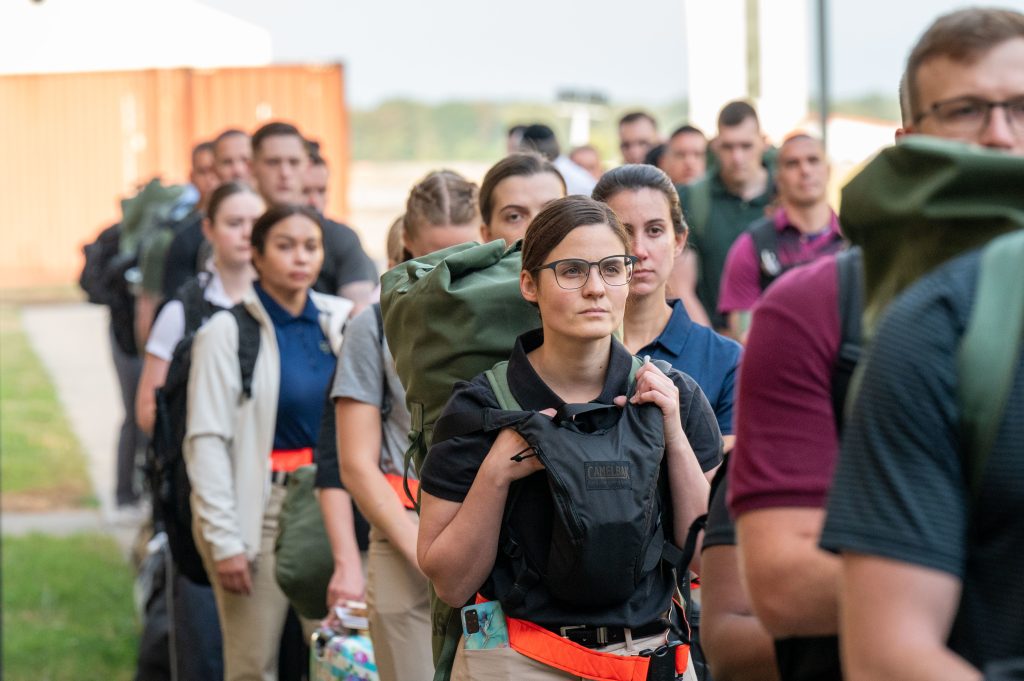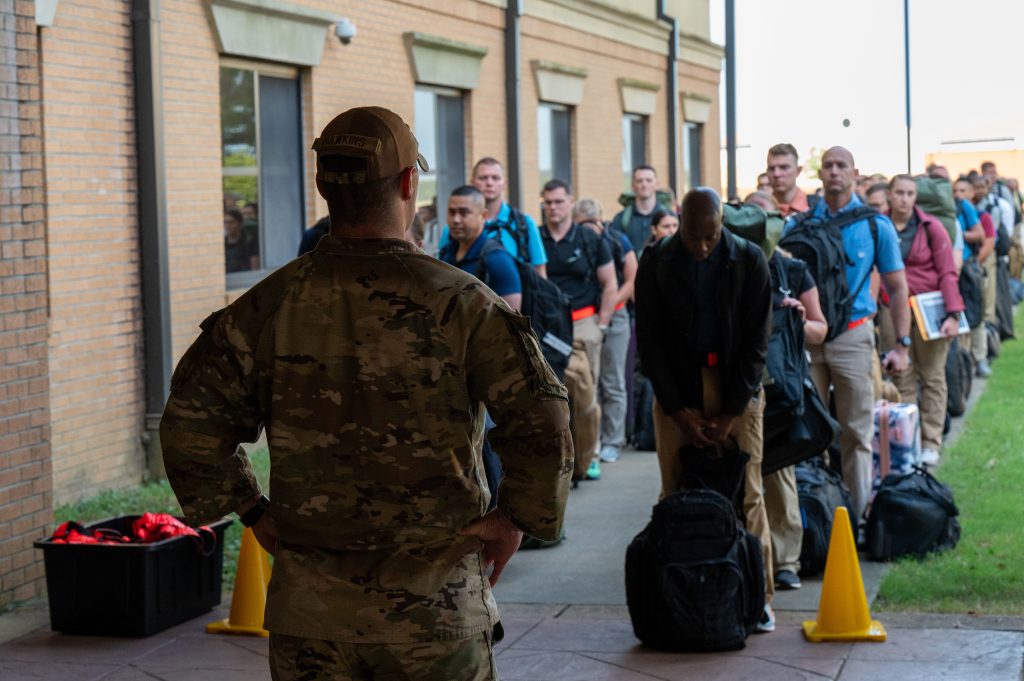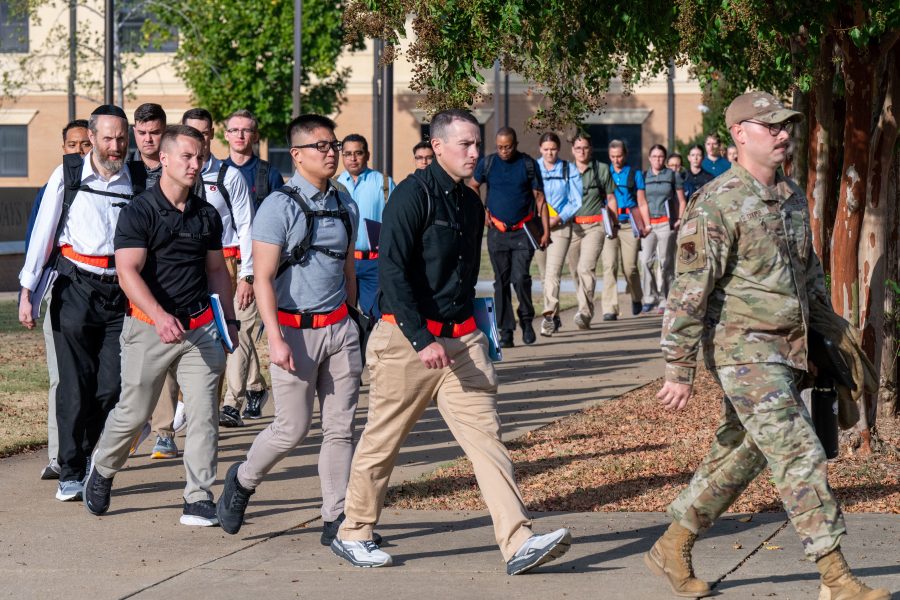As new trainees arrived to their first day at Air Force Officer Training School at Maxwell Air Force Base, Ala., on Oct. 10, they found themselves in the middle of what OTS Commandant Col. Keolani Bailey described as the school’s biggest change in its 64-year history.
Called OTS-Victory, the new program is meant to give trainees more hands-on experiences; make them better prepared for joint, near-peer conflicts; grow instructors into experts on specific leadership skills; and make it easier for OTS to train more officers in a time of crisis.
“It’s the most transformational change in the history of OTS because every facet of everything we do is different and it’s all done within the same 60 training days,” deputy commandant Col. Derrick Iwanenko told Air & Space Forces Magazine. “Same amount of days, same amount of instructors, but because of how the course is now structured … it’s concentrated in a far better manner to produce a better graduate at the end.”
Modules
Unlike the U.S. Air Force Academy and Reserve Officer Training Corps, OTS turns civilians or prior enlisted service members who already have college degrees into Air Force and Space Force officers over the course of 60 days rather than two to four years. The new course is still 60 days long, but the layout is now broken into five modules.
In the first module, trainees learn the basics of military life such as customs, culture, drill, dorm, and uniform standards. In modules two and three, they are introduced to Air Force organizational structures, wargaming, and basic leadership skills, while module four prepares them to plan and conduct a field exercise called a ‘mission command experience.’

The fifth and final module trains trainees on concepts they will likely encounter in a conflict, including anti-access/area denial, Agile Combat Employment, rapid mobilization, and ‘strategic competition,’ the Department of Defense’s term for competing with near-peer powers such as China and Russia. It also includes a capstone event known as the Commandant’s Challenge, where trainees will test all the skills they learned over the previous 60 days.
Unlike previous editions of OTS, where a single set of instructors taught the entire curriculum, instructors specialize in a certain module in OTS-Victory. Bailey said the change should reduce lesson-planning time, allow instructors to become experts in certain skills, and give them more breathing room in between classes.
“The instructors become so much more efficient and effective,” under the new construct, Bailey said. “Now they become the experts in their two-week modules, and they are able to deliver that content at such a higher level.”
Hands-On Application
The instruction itself will be revamped to tie in more real-life stories from Air Force service. A typical day might begin with a TED Talk-style presentation by an officer or noncommissioned officer about a personal experience that illustrates the leadership lesson of the day. The presentation is meant to help trainees learn through the ‘affective’ domain—what Bailey described as “through the heart.”
After the presentation, the students then hit the classroom to learn the lesson in the cognitive domain—“through the head”—and then they apply those lessons in hands-on experiences meant to target the behavioral domain, “the training piece.”
There is more emphasis on training in OTS-Victory than in previous iterations, Iwanenko said. For example, if the lesson is on change management, there will be an exercise where trainees must plan an operation, but when they go out to execute it, they will get an “intel drop” that will force them to change the operation and implement the lessons they learned earlier.
“The way that we would assess change management previously would be through an academic assessment, a test,” he said. “That’s more just rote memorization. Now we’re purposeful in having them exercise through the behavioral domain, that actual hands-on application, the theory they just learned about in the classroom.”

Bailey added that the real learning takes place during the debrief afterwards, where trainees get feedback on their decisions. Another example of the behavioral domain is the mission command exercise during module four. The MCE could take the form of a multi-domain lab, where trainees use flight simulators and command-and-control networks to oversee or execute a mission; a wargame where trainees lead a combined joint task force in a fictional conflict; or a capstone event where trainees practice agile combat employment operations, a concept where Airmen operate from small airfields that may be isolated from higher levels of command. Practice makes perfect, so each trainee will participate in 15 MCEs during the course and lead at least one.
“They plan, they brief, they write mission-type orders, execute the mission, and then debrief,” Bailey said. “They get lots of reps and sets going through this experience so it becomes natural for them to then operate in the joint environment we need for the future fight.”
Shock Absorber
Since OTS takes less time than ROTC and the Air Force Academy, the school acts as a “shock absorber” that can ramp up officer production in times of need, Bailey explained. OTS-Victory amplifies that capability by graduating 20 or 21 smaller class sizes per year–with a surge capacity of 26–instead of five graduations of larger classes a year under the old system. The change should make it easier to schedule trainees and instructors.
“These different levers that we’ve orchestrated into this structure allow us to be more responsive to increases or decreases in demand,” he said.
Under the old model, each graduating class was about 500 to 550 students, while the new model will be about 155, with capacity to max out at 175. The yearly output under the old model was 3,000 students a year, which Bailey said was difficult to meet under the old construct. OTS-Victory should allow the school to meet that goal more easily, with room to scale up if the need arises.

Under OTS-Victory, there will typically be five different classes in session, each at a different point in the training course. The staggered schedule means trainees in modules four and five are considered ‘upper class’ who can mentor their colleagues in the lower modules, a construct that has not existed at OTS since at least 2009.
There may be growing pains in the months ahead as the school implements the new changes, but Bailey is sure of their course.
“We’re four hours into it with this first day of OTS-Victory, so we’re excited today but I’m sure there’s going to be things that we learn and improve” he said Oct. 10. “But the nice thing about it is the structure that we’ve created has really built in a system of continuous improvement, feedback and growth.
“Everything we do is geared towards building that warrior-minded leader of character,” he added, “one who embodies a disciplined mindset, willing to accept challenges, persevere, and overcome for those they serve.”
